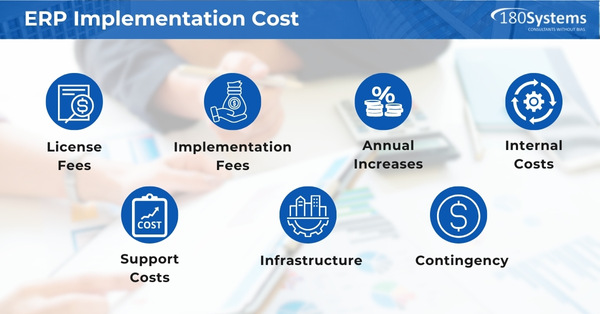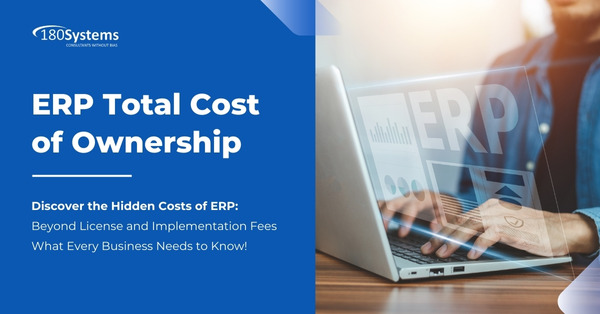ERP Implementation Cost: How Much Does an ERP Software Cost?
When considering the total ERP software cost, it’s not just license fees and implementation costs that you need to consider. There are also annual increases, internal, support, infrastructure, and unexpected costs (contingency). These costs form the foundation of the ERP Total Cost of Ownership, which must be evaluated before selecting a system.
These ERP software costs will depend on the size and complexity of your company which can be segregated into 3 tiers:
1. Tier One ERP / Enterprise Company
- Revenues > $250M
- Employees > 500
- Annual license fees > $200k
- Implementation Fees : Annual License Fees >3:1
2. Tier Two ERP /Mid Market Company
- Revenues $25M-$250M
- Employees 50-500
- Annual license Fees $50k-$200k
- Implementation Fees : Annual License Fees > 1.5:1
3. Tier Three ERP /Small Business Company
- Revenues < $25M
- Employees < 100
- Annual license Fees < $50k
- Implementation Fees : Annual License Fees <= 1.5:1
Below we will describe the ERP software cost to consider as well as estimate the costs for a mid market company requiring a Tier Two ERP system.

ERP Software Cost Breakdown
1. License Fees
Not long ago, the ERP vendors charged you a one-time license fee and a % maintenance charge of about 20% per year. That ERP pricing model is now just about obsolete. The ERP vendors have embraced the cloud or Software as a Service SaaS model and will charge you an annual fee for software licensing, maintenance and hosting. The vendors recover their one-time license fee in a few years and continue to charge their annual subscription fees for life (annuity for life). Their clients are reluctant to select and implement a new ERP software because of the high costs to do it. However, if the ERP vendors don’t invest in their systems, their clients will get off their cloud.
The annual fee covers the R&D to enhance the system and to fix bugs, but it does not include the actual ERP software cost or ERP price to perform major upgrade. Some ERP systems will automatically be upgraded as each client is on the same version because the system is built using multi-tenant architecture. Other ERP systems will require implementation work when upgrades are released.
It’s difficult to figure out the ERP software cost per user because of all the variables which include:
- The Tier – Each Tier (One, Two, and Three) has different costs
- The number of users.
- Whether 3rd party costs are needed.
- Whether the license is for all functionality or by module.
- Whether there is a light user license. A light user license would be a lower cost and could be used for read only users, warehouse and production users working with a handheld device or for limited use functionality like requisitions or time entry.
- Other costs such as additional ERP software cost for each location/site.
- The type of user – some vendors charge based on concurrent users and other charge based on named users. There can be a significant difference in costs if you have lots of users who occasionally need the system and are ok for them to share licenses.
- Discounts – Vendors are prepared to make significant discounts under certain conditions to make the deal. You can expect 10%-50% discount with appropriate contract negotiation.
The going rate for an ERP subscription fee averages about $2,500/year per concurrent user. Assuming a mid market company with 40 concurrent users, the ERP software license cost will be $100,000.
2. Implementation Fees
The ERP vendors are guessing when quoting ERP software cost or ERP implementation costs and protect themselves with many assumptions including:
- Time & Materials estimate rather than fixed cost.
- High-level scope of work that no one can dispute.
- Roles and assumptions which will have their clients doing work for which they don’t understand or are qualified to complete. A classic example is preparing the documentation of the agreed upon (To-Be) business processes.
- Implementing what they consider best practice which may not be appropriate for their clients.
- Exclusions which could be something needed such as personalization of forms or custom reports.
However, the vendors can’t be blamed for being cautious because of all of the unknowns when estimating the ERP costs of implementing ERP systems. On the other hand, they are also motivated to keep their actuals within budget. If they don’t, they risk a failed implementation which is not good for their reputation and their annuity for life.
Although the vendors are willing to discount their annual subscription fees, they are understandably reluctant to discount their implementation fees as they need to pay their people. You can negotiate the rates somewhat and you can reduce scope to bring down the ERP software cost of implementation.
As a rule of thumb for ERP pricing, implementation fees will be about the same as licence fees or somewhat higher depending on the complexity of the system and whether the organization will be able to use it without much tweaking. For our example, let’s assume a 2:1 ratio, or $200,000 which would likely occur over multiple years.
Many ERP vendors use time-and-materials models, making it critical to budget contingency. Our ERP Software Selection Methodology includes vendor evaluation criteria to avoid scope misalignment.
3. Annual Increases
You need to read the fine print of the vendor contract very carefully for the ERP software cost. There is going to be a price increase in annual fees/user and in implementation rates. You will often see a 6% bump in license cost/user but you can negotiate the % to a more tolerable amount. Also don’t assume that the % increase applies to new licenses. These may very well be at list ERP pricing unless you negotiate. ERP consultant rate inevitably will increase, but you can also negotiate these increases for cost effective.
To control long-term ERP costs, negotiate license caps and pricing escalations during the contracting phase. See our guide on ERP Contract Negotiations.
4. Internal Costs
You are going to need your A team on this project. You probably can’t afford for them to forsake their daily duties, so you will allocate a certain percentage of their time to the project. Also, you may need to hire additional resources to cover for the A team’s absence. The project will need business process owners and subject matter experts, who know the business and must be existing employees. But you may not have the skill sets for some of the work to be done – namely project management and IT. You can hire external resources to do this work or at least coach your internal resources until such time they can do it on their own. For our example, we assume the following internal resources and no external resources:
| Role | Description | Time Commitment (% per week) | Number of people | Annual Cost | Project Cost |
|---|---|---|---|---|---|
| Project/Executive Sponsor | High-level executive who provides strategic direction, resources, and support for the project. They champion the project within the organization and help remove obstacles to ensure its success. | 10% | 1 | $200,000 | $20,000 |
| Project Manager | Responsible for overall planning, execution, and success of the project. They coordinate tasks, manage resources, and monitor progress. | 75% | 1 | $150,000 | $112,500 |
| Core Team Leads | Collaborate with the technology vendor team to design the solution for their domain. They help design and validate the technology solution to meet their requirements. | 25% | 5 | $150,000 | $187,500 |
| Subject Matter Experts | Support the core team leads. The Subject matter experts bring deep domain knowledge to the project to help design the technology solution to meet key requirements. | 20% | 5 | $100,000 | $100,000 |
| Total | $420,000 |
There will also be ongoing internal costs to maintain the ERP system because of upgrades, bugs an enhancements. You should assume an ongoing fee of 10% of the ERP implementation fees.
Some people believe that an ERP software will make the company more efficient, and you will be able to reduce the number of employees. However, what usually happens is that the existing employees are able to do more value-added work and the company can grow without hiring new employees. These internal resource commitments are a key component of total ERP cost of ownership, often exceeding implementation fees.
5. Support Costs
You will always need support for your ERP system. Unfortunately, the license fees usually do not include these costs. This is not surprising in that some customers are relatively self sufficient but others call at the drop of a hat.
We recommend 10% of license costs annually to cover vendor and internal support as part of your ERP software cost.
6. Infrastructure
Infrastructure costs are generally the lowest costs to consider in an investment mostly because the vendor is hosting the system which includes the hardware, database, operating systems and security. However, you may need to upgrade your internet connections and add some equipment for employees that used to work with paper.
7. Contingency
Unexpected costs always arise, no matter how hard you try to lock down the scope and control the budget. It can happen for many reasons including:
- Scope change because of a change in the business or a new opportunity.
- Your team overlooked something—mistakes happen.
- Misunderstanding by the vendor. It’s usually better to pay the vendor for their time to get the job done and the system working than to fight it out or to take them to court. The vendors can make honest mistakes.
- Customizations take longer than expected
Build in contingency of at least 20% for the 1st few years and 10% for subsequent years.
Sample Total ERP Software Cost for a Mid Market Company (Tier Two)
Here is a five-year projection for a Tier Two organization.
| Assumptions | |
|---|---|
| Annual Rate Increase | 3% |
| Change in number of employees | None |
| Contingency - 1st 2 years | 20% |
| Contingency - subsequent years | 10% |
| Total Implementation | $200,000 |
| % in 1st year | 75% |
| % in 2nd year | 25% |
| Total internal costs | $420,000 |
| Ongoing internal cost % post implementation | 5% |
| Vendor Support % | 10% |
| Cost Type | Year 1 | Year 2 | Year 3 | Year 4 | Year 5 | Total | % |
|---|---|---|---|---|---|---|---|
| License | $100,000 | $103,000 | $106,090 | $109,273 | $112,551 | $530,914 | 36% |
| Implementation | $150,000 | $50,000 | $200,000 | 13% | |||
| Internal costs | $315,000 | $105,000 | $21,000 | $21,000 | $21,000 | $483,000 | 32% |
| Support | $20,000 | $20,600 | $21,218 | $21,855 | $83,673 | 6% | |
| Infrastructure | $10,000 | $10,000 | $10,000 | $10,000 | $10,000 | $50,000 | 3% |
| Contingency | $40,000 | $40,000 | $20,000 | $20,000 | $20,000 | $140,000 | 9% |
| Total | $615,000 | $328,000 | $177,690 | $181,491 | $185,405 | $1,487,586 | 100% |
Summary: Why ERP Total Cost of Ownership Matters
Investing an ERP software is similar to buying a home. You will often encounter surprises when you move into the house that emerge in the 1st year especially but also occur in subsequent years. Your home will cost you dearly, but it will also bring stability and hopefully some joy to your life. Don’t expect any joy from your ERP software, but ERP solution should being stability to your business and a foundation for future growth.
Understanding total ERP costs—license, implementation, internal resources, support, and contingency—helps you plan, budget, and negotiate from a position of strength.
Why Work with Independent ERP Consultants?
At 180 Systems, we are independent ERP selection consultants and do not sell or implement any product or accept any compensation from vendors or implementers for our advice or services. Our only goal is to help you choose the right system and optimize your ERP investment.
Contact 180 Systems to learn more about:
-
ERP budgeting and cost analysis
-
ERP selection strategy
-
ERP project advisory and RFP support

